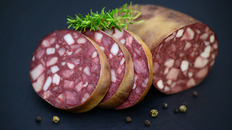Meats and Sausages
Bloempanch
Bloempanch also known as Bloedpens has a long history in Belgium. At one time it was almost a daily food of those who couldn’t afford meat which gave another nickname to this product, “steak of the poor.” The word panch refers to the stomach of an animal, in this case a cow. Following the traditional recipe all of the ingredients are packed into a cow stomach creating a sausage of about 15 cm in diameter. Previously, pig bladders could also be used. Compared to most sausages Bloempanch is very large and its main characteristic are large cubes of pure white fat that gave the sausage a peculiar nickname: bufsteik mi rooite (“beefsteak with squares”).
| Meats | Metric | US |
|---|---|---|
| Pork meat trimmings-head, shoulder, leg | 300 g | 0.66 lb |
| Pork back fat | 350 g | 0.77 lb |
| Beef blood | 350 ml | 11 oz fl |
Ingredients per 1000g (1 kg) of meat
| Salt | 12 g | 3 tsp |
| Black pepper | 2.0 g | 1 tsp |
| White pepper | 1.0 g | 1/2 tsp |
| Cayenne | 0.5 g | 1/4 tsp |
| Cinnamon | 1.0 g | 1/2 tsp |
| Nutmeg | 1.0 g | 1/2 tsp |
| Cloves, ground | 0.3 g | 1/8 tsp |
| Ginger | 0.5 g | 1/4 tsp |
Instructions
- Grind meat through 1/4” (6 mm) plate.
- Dice partially frozen back fat into 1/2” (12 mm) cubes.
- Mix ground meat with salt and spices.
- Add fat cubes and mix again.
- Stuff into beef (or pork) stomach.
- Cook in hot water at 80° C (176° F) until the sausage reaches 72° C (160° F) internal temperature what should take about 2 hours. Partially cool in cold water, finish cooling in the air.
- Refrigerate. Sausage can be eaten cold or hot.


















